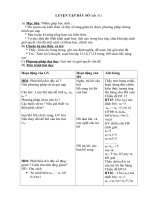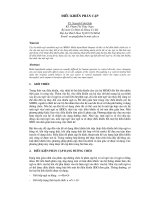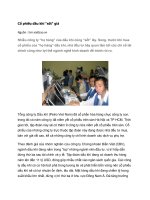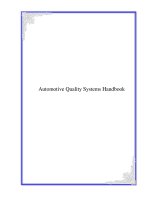Tài liệu GeoSource Heat Pump Handbook pptx
Bạn đang xem bản rút gọn của tài liệu. Xem và tải ngay bản đầy đủ của tài liệu tại đây (611.28 KB, 89 trang )
GeoSource
Heat Pump
Handbook
ECONAR ENERGY SYSTEMS
Corporate Offices
1135 West Main
Anoka, Mn. 55303
33
West
Veum
Appleton,
Mn. 56208
Bus. (612) 422-4002 Fax. (612) 422-1551
Sales 1-800-4-ECONAR
More ebooks : />First Edition
( March 1991 )
Second Edition ( February 1993 )
This publication could include technical inaccuracies
or typographical errors. Changes are periodically made
to the information herein; these changes will be made
in later editions. Econar Energy Systems Corporation
may make improvements and / or changes in the
product (s) at any time.
For copies of publications related to GeoSource
Heat Pumps, call l-800-4-Econar.
More ebooks : />Acknowledgements
Many people over the years have contributed to the
conception, creation, implementation, growth, and
education of the ground source heat pump industry.
This handbook is an attempt to compile the numerous
references and life experiences existing to date.
More ebooks : />Contents
1 Introduction
History
01
Types of Heat Pumps
02
Basic Operation
03
2 Applications
Types
05
Configurations
07
3 Economics
Benefits
11
Costs
13
4 Load Estimating
Heat Transfer
23
Design Conditions
26
Heat Loss
29
Heat Gain
32
i
More ebooks : />5 Air Distribution
Ventilation
39
Duct Design
41
Air Balance and Noise Attenuation
45
6 Open System Design (Well Water)
Water Requirements
47
Pressure Tanks
48
Open System Piping
48
Water Discharge
49
7 Earth Loop Design
Materials
51
Earth Loop Fabrication Practices
51
Antifreeze Solutions
53
Loop Design and Sizing
56
Pumping Requirements
58
System Purging
63
ii
More ebooks : />8 System Design and Installation
Selecting a System
. . . . . . . . .
67
Sizing The Heat Pump
. . . . . . . . . . . . . . . . . . . . . . . . . . . . . . . . . . . . .
67
9 Maintenance
69
10 Glossary
71
References
77
iii
More ebooks : />1 Introduction
What is a heat pump? A heat pump is a mechanical
device used for heating and cooling which operates on the
principle that heat can be pumped from a cooler
temperature to a warmer temperature (cold to hot). Heat
pumps can draw heat from a number of sources, eg, air,
water, or earth, and are most often either air-source or
water-source.
Although heat pumps have been around for more than a
100 years, the technology has dramatically increased. Not
only do heat pumps still operate the common refrigerator,
but today, heat pump technology allows us to heat and
cool residential and commercial buildings.
Because of modem innovation, people using heat pumps
are now able to save 50-70 percent on their annual heating
and cooling costs.
History
The heat pump industry goes back a long way beginning
in 1824 when Nicholas Carnot first proposed the concept.
While heat normally flows from warmer areas to cooler
areas, Carnot reasoned that a mechanical device could be
used to reverse that natural process and pump heat from a
cooler region to a warmer region.
In the early 1850’s, Lord Kelvin expanded on the heat
pump concept by proposing that refrigerating equipment
could be used for heating. Other scientists and engineers
sought to develop a feasible heat pump for comfort
heating, but none were successfully constructed until the
mid-1930s when a few privately financed heat pumps were
experimentally installed. These demonstration installations
increased after World War II, and it was soon clear that
heat pumps could be commercially feasible if completely
assembled systems could be made available in quantity.
The first heat pump products were available for sale in
1952.
1
More ebooks : />Types of Heat Pumps
Air Source Heat Pump
The air source heat pump exchanges heat between the
outside air and the inside air.
When the outside air
temperature is between 4O°F and 90°F these units are
relatively efficient. However, as the temperature
difference between the outside and inside air increases, the
efficiency of the unit decreases. To overcome the loss of
heating capacity these units require auxiliary electric
heaters.
Water Source Heat Pump
The water source heat pump exchanges heat between
water and the inside air.
The water source heat pump is
commonly used in commercial buildings using a boiler and
cooling tower which keeps the loop water temperature
between 60°F and 90°F.
As a rule water source heat
pumps have a lower operating cost but higher initial cost
than air source heat pumps. This difference is due to
water side costs of the system rather than air side cost.
Ground Source Heat Pump (GeoSource)
The GeoSource heat pump utilizes the earth as the
medium from which heat is extracted. Water is pumped
through a heat exchanger in the heat pump. Heat is
extracted, and the water is then returned to the ground,
either through discharge on a drain field or through a
closed earth loop system. Because ground temperatures do
not vary as dramatically as outside air temperatures, the
heat available for transfer, as well as the unit’s operating
efficiency remains relatively constant throughout the
winter.
At depths of 15 feet or more below the ground,
the soil maintains a year-round temperature of about 43°F
-52°F in this region.
So in the summer, it’s cooler than
the outside air, and in the winter, it’s warmer making it
an ideal energy source.
Although the initial installation cost may be higher,
annual operating costs are much lower than all other
2
More ebooks : />types of heating systems. The added savings carry over to
summer where cooling costs can be 30%-50% less than
the cost of cooling with an average central air conditioning
system.
The GeoSource heat pump uses water circulating
through buried pipes. This water can be from a well, or
merely part of a closed network of pipes that is looped
horizontally or vertically in the ground.
As the ground
temperature water reaches the heat pump, its heat is
absorbed by a low-pressure liquid refrigerant which then
vaporizes. It is then compressed to about 160 degrees and
moves to the air heat exchanger.
Since the temperature in
the house is cooler than the refrigerant, a law of physics
takes over and the heat is released. Then, during the
summer, the refrigerant’s flow is reversed, enabling it to
cool the house.
3
Basic Operation
More ebooks : />4
More ebooks : />2 Applications
Types
Open System (Well Water)
If you have an adequate well water supply, you may
want to consider a system that uses well water as its heat
source.
Water from a well, usually the same well that
supplies your other water needs, is pumped through the
indoor heat pump and then returned to the underground
aquifer via an open discharge into a lake, pond or stream.
When operating, the system usually requires 1 1/2
gallons of water per minute, for each ton of heating and
cooling capacity.
Horizontal Earth Coil System
Instead of extracting water from the ground and
returning it to the ground, this system circulates water
through a closed series of horizontal 1oops.
These loops
consist of high density polyethylene buried 5 to 6 feet deep
or deeper, which allows direct contact with moist soil.
5
More ebooks : />Approximately 500-600 feet of underground pipe is
needed for each ton of heating and cooling capacity
required.
The horizontal loop system uses a fixed volume of
water. Once the loop has been filled, no additional water
isrequired.
During the winter, water in the loop line absorbs heat
from the surrounding earth and transfers it into your
home. In the summer, heat from your home is collected
by the heat pump, transferred to the water, and pumped
through the buried coil, where the heat is absorbed by the
cooler soil.
Slinky
A deviation of the straight pipe horizontal earth coil.
Slinky pipe is straight pipe laid “coiled” in a trench.
A
slinky earth coil requires approximately 600-1000 feet of
underground pipe per ton but requires substantially less
land area.
Vertical Earth Coil System
In the vertical system, a fixed volume of water circulates
through a closed loop of pipe buried vertically, usually to
a depth of 150-185 feet. Each ton of heating and cooling
capacity requires about 340-400 feet of underground
piping.
6
More ebooks : />With both the vertical and horizontal systems, the water
contains an antifreeze solution. This is to eliminate any
possibility of freezing during periods of peak use when
cooler return water circulates through the pipes and lowers
the temperature of the surrounding soil.
Like the horizontal system, the vertical coil is a closed
pipe configuration that is filled only once.
Configurations
Forced Air
Forced air systems use a blower to move and circulate
air to its proper destination points.
The air circulated
travels through a series of ducts to heat and cool a
structure.
The forced air distribution system is the most commonly
used system installed today. There are advantages in
using this system. First, an even amount of air flows
throughout the ductwork continuously. Secondly, filters
can be used to remove 80-90% of the pollutants existing in
the air. Lastly, air conditioning would not be possible
without a forced air type of system.
7
More ebooks : />Many configurations of a forced air system are
available. For example, a verticle (up flow) type of
system is used to replace the conventional furnace in a
home. However, where space is limited, a horizontal
(counter flow) configuration would be ideal for an
overhead installation in a commercial building or crawl
space at home.
Hydronic
Hydronic or hot water heating systems provide a
smooth, even heat but no air conditioning. Residential
hydronic heating systems are most often found in the
northeastern United States and Canada.
Conventional, boiler-fired hydronic systems are usually
designed for 160F water leaving the boiler and a 20F
temperature drop in the water loop. It is common for the
piping and circulator pump to be sized for 10 gpm at 6 feet
of head pressure. The standard 3/4-inch fin tube
baseboard convectors have an average output of 230
Btuh/foot at 120°F entering water temperature.
There are several differences with a GeoSource hydronic
heating system. First and foremost, the leaving water
temperature is about 120°F instead of 160°F. Second, due
to the friction loss in the heat exchanger, the circulation
pump must produce at least 18 feet of head pressure.
Due to the lower water temperature of a GeoSource
system, it often requires 200 linear feet of baseboard
coverage or full perimeter baseboard convertors.
Cast
iron radiators will transfer 70 Btuh/square inch at 130F
entering water. Cast iron radiators are excellent for
ground water systems because of their transfer capacity at
lower temperatures.
Polybutylene pipe buried in a concrete slab is also an
excellent application for the lower temperature of
GeoSource hydronic heating.
Domestic Hot Water Heating (Desuperheater)
Domestic hot water heating using a heat pump can
significantly decrease energy costs during both heating and
cooling seasons. A desuperheater is a heat exchanger that
removes the high-grade (high-temperature) superheat
8
More ebooks : />available in the refrigerant gases exiting the heat pump
compressor. Depending on the heat pump design and
operating conditions, superheat temperatures of 200F and
greater may be reached. By removing the superheat,
desuperheaters can provide a source of hot water typically
at a temperature of 160F. For many years, desuperheating
systems (commonly known as “heat reclaimers”) have
been successfully retrofitted on central air conditioning
systems. Industry members reported some 50,000 units
installed during 1985 on central air conditioning. During
cooling, heat pumps operating to provide air conditioning
generate unused heat. This heat can be reclaimed and can
therefore be considered a “free” source of energy for
generating domestic hot water. During the heating mode,
the functions of the condenser and evaporator are reversed
by a four-way reversing valve. This requires the
desuperheater heat exchanger to be installed between the
compressor and the reversing valve.
Heating of hot water
is not “free” but is provided at a reduced cost based on the
heating COP of the heat pump.
On GeoSource heat pumps, desuperheaters may provide
most of the domestic hot water required for a typical
residence. During summer cooling cycles entering water
temperatures are higher, resulting in higher desuperheater
temperature. In winter, domestic hot water production
will be reduced because of the lower entering water
temperatures from both the domestic water supply system
and the ground heat exchanger.
Domestic Hot Water Options
In addition to space heating and cooling, GeoSource
heat pumps are available with three specific domestic hot
water options:
1. NONE: No hot water preheating capability.
2. SUPPLEMENTAL: Partial preheating (desuperheater)
during heat pump operation in the heating or cooling
cycle.
3. DEMAND: Year-round total (full condensing water
heating) hot water heating on a first priority basis.
9
More ebooks : />Option 1 - A conventional GeoSource heat pump without
provision for domestic hot water preheating. This
configuration represents the lowest cost GeoSource heat
pump. It is used in buildings with more than one heat
pump and where there is no requirement for domestic hot
water.
Option 2 - Uses a refrigerant-to-water heat exchanger
(desuperheater) installed at the discharge of the heat pump
compressor. The hot gas at this point is in a
"superheated" condition giving rise to the common name
desuperheater. "Free hot water" is available during the
cooling season. In the winter, the desuperheater
generating domestic hot water competes with the heating
load.
Since there is generally excess heat pump capacity
for many winter hours, domestic hot water efficiency
equals heat pump efficiency.
If the hot water demand has
been met, the circulating pump is shut off.
Option 3 - Total or 100% domestic hot water on a first
priority basis simply means that, before any space heating
or cooling is accomplished, all domestic hot water
requirements are met by the heat pump system. These
units have a completely different design.
Heat pumps with
this feature will have the longest-run cycles. This usually
improves heat pump performance and generally reduces
the total annual demand and energy cost.
10
More ebooks : />Benefits
Benefits to Homeowner
3 Economics
The GeoSource Heat Pump system reduces demand and
lowers energy consumption. For the consumer this means
lower utility bills. In cases where utilities are providing
low-interest loans or incentive programs, the consumer
often sees an immediate positive cash flow. In many
applications, the ground temperature during mid-wmter
can be 40 degrees warmer than the coldest air
temperature. This significantly increases both the capacity
and efficiency of the heat pump system.
Depending on
geographic location, GeoSource heat pump systems have
reduced heating costs 75 % more than electric furnaces and
about 50 % more than air-source units. In extreme
northern climates, the advantage over air-source heat
pumps for heating has been even greater. Also, reduced
improvements in cooling costs have been around 25 % over
high efficiency convential air conditioners.
An additional advantage of the system is reduced
maintenance. The unit is indoors, which gives the
electrical components a greater life expectance. There are
fewer components. For example, the defrost cycle
required in an air-source system has been eliminated.
Finally, the compressor operates under less severe
conditions than air-source heat pumps which have a
proven life expectancy that approaches 20 years.
Water requirements of the closed-loop system consist
simply of a single filling of the ground heat exchanger
system. For a residence, this is approximately 50 to 100
gallons. For an open system, where water is discharged to
a pond or drainage ditch, a typical heat pump system in
the Midwest using six gallons per minute would use under
one million gallons each year for both heating and cooling.
In locations with limited underground water the closed -
loop system may be the only choice.
11
More ebooks : />All contractors and businessmen who have excellent
products with demonstrated desirable performance will
benefit from having newly developed products for sale.
Benefits to Utility
For the electric utility, this system will provide
sufficient improvements in efficiency that other fuel users
can be convinced to use electric heating and cooling
systems.
In many cases this can be done without
increasing the utility’s service size. Gas customers with
electric air conditioning can generally be provided heating
without an increase in electric service size.
Domestic hot water preheating occurs only during heat
pump usage and leaves the demand valleys open for
conventional hot water heating. Properly marketed, this
system should increase kilowatt-hour sales by attracting
other fuel users.
Environmentally speaking, natures best friend has to be
the GeoSource heat pump. GeoSource Heat Pumps
merely move the earths natural energy from one point and
transfers it to another. On the other hand, fossil burning
systems strip our land of scarce resources and later emit
burned off pollutants into the earths atmosphere.
Benefits to HVAC Contractor
The contractor benefits from having available to him a
total electric system that:
1. Competes in areas with low-cost fossil fuels for those
consumers who desire electric heating.
2. Is a higher priced system with excellent paybacks, thus
allowing higher profit margins when compared to
conventional equipment.
3. Is simple in operation with an expected lifetime
exceeding that of conventional gas and electric systems.
Environment
12
More ebooks : />Additional Benefits from Demand Hot Water
GeoSource Heat Pumps
This heat pump has the capacity for space heating,
space cooling, and producing 100% of the domestic hot
water on demand. This allows the unit to produce
domestic hot water with the unit’s full capacity at any
time.
Three modes of operation are integrated in the design:
1. Space heating.
2. Space cooling.
3. Dedicated hot water heating on demand.
The demand reduction potential is excellent. During
summer peak demand periods, 100% of the domestic hot
water is generated by the heat pump system as waste heat.
This eliminates the water heating load during the summer
peak demand period.
Costs
GeoSource heat pumps offer numerous advantages over
alternative space heating and cooling systems, including a
clean, safe and highly efficient means of providing space
heating and cooling utilizing a single machine. However,
the greatest factor influencing the purchase decision of
most customers is economics.
Three major cost factors
are considered when comparing heat pump economics with
other alternatives: initial cost, operating cost and
maintenance cost. Methods used to estimate these costs
for various heat pumps follow.
Initial Cost
Initial cost includes all expenditures relating to the
purchase and installation of a heat pump. These may
include:
Equipment: heat pump, wiring, pad, ductwork,
flowmeter, earth loop piping, thermostat, etc.
13
More ebooks : />Table 3.1
Water Well
Pump and
Pressure
Tank
Installed
Cost
Labor: installing, well drilling, trench digging, etc.
Local fees: taxes, permit fees, etc.
Many utilities offer rebates for the installation of
GeoSource heat pumps. These, too, should be considered
in the determination of initial cost.
Initial Cost Considerations For Well Water Systems
Well water systems require the use of a water supply
well. Estimates for supply well drilling can be obtained
from a local contractor.Usually the price includes
drilling, installed casing, bottom screen, gravel grouting
and cement grouting for the top 10 feet.A price quote
will usually not include the cost of water system
components such as pressure tanks and pumps but cost
estimates for these items are provided in Table 3.1.
Most
drilling estimates range from $8-12 per foot of depth,
meaning that a 100-foot well would probably cost between
$800-1200.
1/3 hp $350-400
$300-350
$50-75 32
$200-250
1/2 hp $375-425
$325-375 $50-75 44
$225-275
3/4 hp $450-500 $400-450 $60-80 62
$350-400
1
hP
$525-575 $485-525 $60-80 86
$350-400
14
More ebooks : />Initial Cost Considerations For Earth Loop Systems
Table 3.2
Estimated Cost For Horizontal Earth Loop
Initial cost includes the cost of the earth loop pipes and
trenching cost (for horizontal loops) or bore hole cost (for
vertical loops).
An earth loop heat pump also requires a
circulating pump. Circulating pumps keep the water in the
system moving through the earth loop and the heat pump.
Tables 3.2 and 3.3 provide estimates for some of the
installed costs associated with earth loop heat pump
systems.
Trencher
6-8 in. 1
5 ft
$1.66-1.76
$0.82-0.92
Trencher
6-8 in. 2
4&6 ft
$3.07-3.17
$1.18-1.28
Backhoe
24 in.
1
5 ft
$2.07-2.22
$1.23-1.38
Backhoe
24 in.
2
5 ft
$3.41-3.80
$1.52-1.92
4-6 in
With Loop Materials
and Installation
$5.65 - 6.90
Without Loop Materials
and Installation
$4.50 - 5.80
Table 3.3
Estimated Cost
For Vertical
Earth Loop
15
More ebooks : />Although the earth loop costs increase overall system cost
beyond a convential heating and air conditioning system
the cost of the earth loop can be compared to the consumer
purchasing his or her own oil well and supplying energy
for the life of their home or business.
Operating Cost
The operating cost of any HVAC system represents the
most significant expenditure over the life of the
equipment, often doubling or tripling the initial cost.
Operating cost depends on two factors: (1) energy use of
the system and (2) the price of the energy used.
The
owner has much more control over the first factor than the
second.
If an efficient system such as a GeoSource heat
pump is chosen, energy use will always be low.
GeoSource
heat pump operating costs are not affected by
fluctuating energy rates as less efficient systems are.
Estimating Energy Use
The amount of energy required to heat or cool a home
for an entire year is influenced by a variety of factors,
including climate, building design, characteristics of the
heating and cooling equipment, how the system is
operated, and the control system. The most accurate
methods are those which allow evaluation of building
design, occupant use patterns, heating and cooling
characteristics and local weather data on an hour-by-hour
basis.Various utilities and equipment manufacturers have
developed computer programs which aid analysis of these
factors. Simpler estimation methods are available,
including the heating and cooling degree day method.
Heating Degree Day Method
The heating degree day method is commonly used to
estimate the heating energy consumption of electric
resistance heating equipment, fossil fuel-fired furnaces and
heat pumps. The heating degree day estimating method is
based on two main assumptions:
16
More ebooks : />1. For outdoor temperatures of 65°F and above, on a
long term average a home’s solar and internal gains will
offset heat losses.
2. For outdoor temperatures below 65°F, fuel
consumption will be proportional to the difference
between the mean daily temperature and 65°F. For
example, if the mean temperature is 35°F
(65°F-35°F = 30°F difference), twice as much fuel is
consumed as on days when the mean temperature is 50°F
(65°F-50°F = 15°F difference).
When using the heating degree day method to estimate
energy use in a particular home, Table 3.4 provides useful
degree day information about various areas of the United
States. It lists the long term average annual heating and
cooling degree days for different cities.
Table 3.4
Yearly Average Degree Day Values For U.S. Cities
Bismark, ND
8960
Boston, MA 5634
Cheyenne, WY
7381
Chicago, IL
6639
Cleveland, OH
6351
Detroit, MI
6293
Fargo, ND
9250
Great Falls, MT
7750
Indianapolis, IN
5699
Madison, WI 7720
Minneapolis, MN 8250
528
674
308
713
670
687
605
343
902
424
894
New York, NY
5219
Omaha, NE 6290
Philadelphia, PA 5144
Pittsburgh, PA 5897
Portland, ME
7511
Portland, OR
4635
Salt Lake City, UT
6052
Sioux Falls, SD
9250
Seattle-Takoma, WA 5145
1027
1007
1081
732
292
248
958
605
134
17
More ebooks : />Cooling Degree Day Method
The cooling degree day estimation method predicts the
cooling energy consumption of conventional air
conditioners and heat pumps. It is very similar to the
heating degree day method. The cooling degree day value
for a given day is calculated by subtracting 65°F from the
average temperature of the day. The cooling degree day
method is based on the following assumptions:
1.
Cooling is not needed when the temperature is 65°F or
below
2.
Changes in outdoor humidity do not affect energy
consumption (since this assumption is not always
true, there is a large error factor in cooling degree
day calculations)
3.
Solar and internal loads remain at constant values (this
assumption is not always true, either)
Calculating Heating Energy Usage
The accepted degree day method equation for calculating
annual probable energy consumption of any heating system
is:
Hl x D x 24
E
= - - - - - - - - - - - - - - x Cd
Td x V x C.O.P.
where:
E
= energy consumption for the estimate period
Hl = design heat loss, including infiltration and
ventilation, in Btuh
D
= number of heating degree days for the period
24 = 24 hours per day
Td = temperature difference between maintained
indoor temperature and outdoor design
temperature, in degrees F
18
More ebooks : />C.O.P. =
The efficiency value of the rated equipment
(table 3.5)
V=
heating value of fuel in units consistent with
those used for Hl and E
Cd = correction factor to account for the influence of
internal loads, building mass, insulation level
and base temperature
In addition to the energy consumption predicted by the
above equation, the energy required to operate a fossil fuel
heating system’s fans and pumps should be estimated.
Calculating Coding Energy Usage
Average annual cooling degree day values for major
U.S. cities provided in Table 3.4.
The degree day method for estimating cooling energy
consumption uses the following formula:
Hg x D x 24
E
=
Td x 1000 x SEER
where:
E
= cooling energy consumption, kWh
Hg = design heat gain (cooling load), Btu/h
D= cooling degree days for period
24 = 24 hours per day
Td = temperature difference between maintained
indoor temperature and outdoor design
temperature, degrees F
1000 = conversion factor, Wh/kWh
SEER = seasonal energy efficiency ratio, Btu/Wh
19
More ebooks : />









